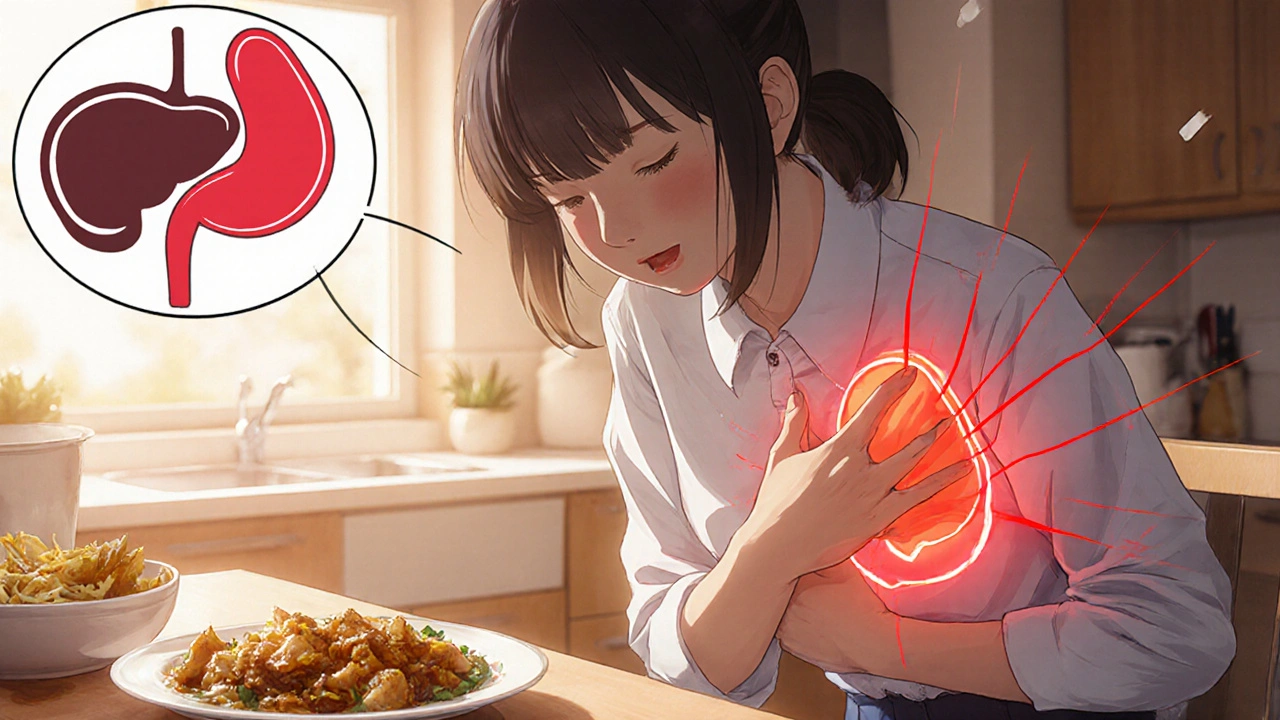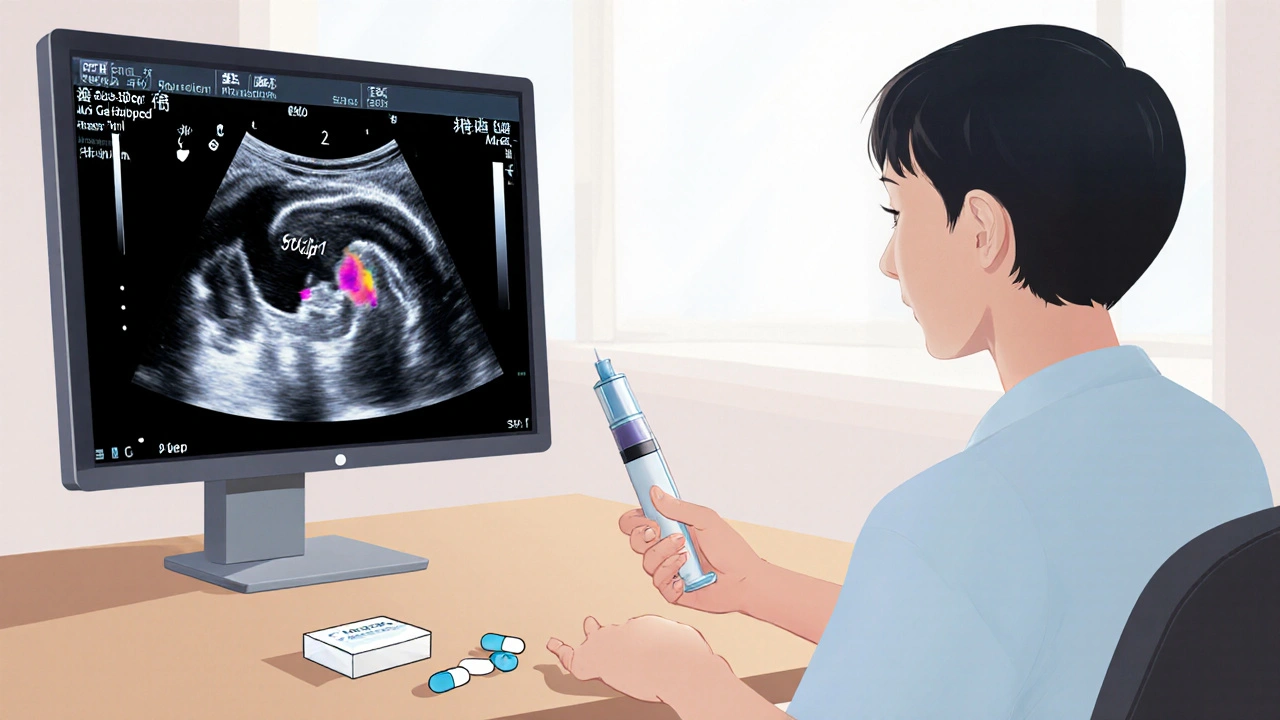GLP-1 Gallbladder Risk Symptom Checker
Check Your Symptoms
Answer these questions to determine if your abdominal pain may indicate gallbladder issues related to GLP-1 therapy.
Your Results
Next Steps:
When doctors prescribe GLP-1 receptor agonists are a class of injectable drugs that mimic the gut hormone glucagon‑like peptide‑1. They lower blood sugar, cut cardiovascular risk, and, more recently, drive dramatic weight loss. But there’s a catch: they can tip the gallbladder into trouble.
GLP-1 agonist gallbladder risk is now on every FDA label, and clinicians are being urged to watch for specific abdominal pain red flags. This guide walks you through the science, the numbers, and what you or your patient should do if warning signs appear.
Why GLP-1 Agonists Affect the Gallbladder
GLP-1 slows gastric emptying, which is why users feel fuller longer. The hormone also dampens cholecystokinin (CCK), the signal that tells the gallbladder to contract and release bile after a fatty meal. With less CCK, the gallbladder hangs around, bile sits idle, and stones can form.
Sarah Hughes, PharmD candidate, summed it up in a 2023 ADCE Connect post: “GLP‑1 inhibition of CCK delays gallbladder emptying, creating a perfect environment for gallstone formation.” The mechanism is consistent across the whole drug class, but the magnitude varies with dose and duration.
How Big Is the Risk?
The 2022 JAMA Internal Medicine meta‑analysis by Dr. Lixia He pooled 76 randomized trials (56,004 participants). Across all GLP‑1 RAs, the relative risk for any gallbladder or biliary event rose 37% (OR ≈ 1.37). In absolute terms, the risk difference was 0.5% (95 % CI 0.3‑0.7 %).
When you drill down:
- Weight‑loss trials (high‑dose semaglutide 2.4 mg, liraglutide 3.0 mg) showed a 1.3 % absolute increase.
- Standard diabetes doses (e.g., semaglutide 1 mg) added only about 0.3 %.
GoodRx’s 2023 real‑world analysis of Ozempic (semaglutide) reported roughly 1 % of users developed gallstones and 0.1 % faced acute cholecystitis. The numbers are low, but when you extrapolate to the 45 million prescriptions written in 2023, hundreds of thousands of people could be affected.
Which GLP‑1 Agonist Carries the Highest Odds?
| Drug (dose) | Odds Ratio (OR) | 95 % CI | Typical weight‑loss effect |
|---|---|---|---|
| Liraglutide 3.0 mg | 2.45 | 1.56‑3.86 | ≈ 15 % loss |
| Semaglutide 2.4 mg | 2.07 | 1.45‑2.96 | ≈ 15 % loss |
| Exenatide 10 µg BID | 1.40 | 0.89‑2.20 | ≈ 5‑10 % loss |
In plain language: the high‑dose obesity formulations roughly double the chance of gallbladder trouble compared with placebo, while the lower‑dose diabetes versions show a modest bump.

Red‑Flag Abdominal Pain Patterns
Most patients tolerate GLP‑1 RAs without any gallbladder symptoms. When trouble does arise, the pain has a recognizable signature. Studies and patient‑report analyses converge on four key red flags:
- Persistent right‑upper‑quadrant (RUQ) pain lasting >30 minutes (sensitivity ≈ 89 %).
- Pain that radiates to the right shoulder (specificity ≈ 82 %).
- Nausea or vomiting accompanying the RUQ ache (positive likelihood ratio ≈ 3.8).
- Post‑prandial pain triggered by fatty foods (94 % specificity).
If any of these appear, the American Association of Clinical Endocrinology’s 2023 guide says: order an urgent abdominal ultrasound and hold the GLP‑1 agent until the work‑up is complete.
Who Is Most at Risk?
Baseline gallstone prevalence matters. Women over 40 with obesity, rapid weight loss (>1.5 kg/week), or a prior gallstone history are especially vulnerable. The AACE recommends a baseline ultrasound for patients with any of the following:
- Female sex and age > 40 years.
- BMI > 30 kg/m².
- History of gallstones or cholecystitis.
- Planned rapid weight loss (> 1 kg/week).
Patients who have already had a cholecystectomy have a dramatically lower risk-Mochi Health’s 2023 analysis found virtually no new gallbladder events in that group.

Management When Gallbladder Issues Surface
First step: stop the GLP‑1 drug. In the Woronow 2022 case series, 78 % of patients discontinued the medication after acute cholecystitis was diagnosed. Most (75 %) eventually required cholecystectomy, often within the first year of therapy (median onset ≈ 180 days).
If a patient still needs glycemic control or weight‑loss support, clinicians can consider alternatives that lack a gallbladder signal, such as:
- Orlistat (lower gallbladder risk but higher GI side‑effects).
- Phentermine‑topiramate (no significant gallbladder association).
For those who cannot switch, some specialists are experimenting with ursodeoxycholic acid (UDCA) to keep bile fluid. A Mayo Clinic phase‑2 trial (NCT05678901) is currently recruiting high‑risk patients.
Practical Tips for Patients and Providers
- Before starting: Assess risk factors, consider a baseline ultrasound.
- Education: Explain the four red‑flag pain patterns and advise immediate medical attention if they appear.
- Monitoring: Schedule a follow‑up ultrasound at 3‑6 months for high‑risk individuals.
- Dose strategy: Use the lowest effective dose for diabetes; reserve high‑dose formulations for patients without gallbladder risk.
- Weight‑loss pacing: Aim for 0.5‑1 kg/week to reduce stone formation risk (Endocrine Society 2024 guideline).
Following these steps can help you reap the cardiovascular and metabolic benefits of GLP‑1 therapy while sidestepping a painful gallbladder episode.
Future Outlook
The FDA’s 2023 label update and the surge in adverse‑event reports (1,842 gallbladder events in 2023, a 217 % jump from 2021) signal that regulators are taking the signal seriously. By 2026, most manufacturers plan to bundle a gallbladder‑risk assessment tool with their patient‑support programs.
Meanwhile, research keeps chipping away at the problem. Preliminary data from Dr. He’s follow‑up cohort suggest the hazard peaks in the first six months (HR ≈ 3.2) and then tapers as the body adapts. If you start a GLP‑1 agent now, stay extra vigilant during that early window.
How soon after starting a GLP‑1 agonist can gallbladder issues appear?
Most cases surface between 3 and 9 months, with a median onset around 180 days. Early vigilance-especially in the first six months-can catch problems before they require surgery.
Do I have to stop my GLP‑1 drug if I have a gallstone but no pain?
If you have asymptomatic stones, discuss risk with your provider. Some clinicians continue therapy with close imaging follow‑up, while others prefer an alternative drug to avoid stone migration.
Can the risk be reduced without stopping the medication?
Slower weight‑loss targets (0.5‑1 kg/week) and low‑fat diets lessen bile stasis. Ongoing trials are testing ursodeoxycholic acid as a preventative co‑therapy.
Is the gallbladder risk the same for all GLP‑1 drugs?
No. High‑dose obesity formulations (liraglutide 3.0 mg, semaglutide 2.4 mg) show roughly double the odds of gallbladder events compared with lower‑dose diabetes versions.
What should I do if I experience RUQ pain while on a GLP‑1 agonist?
Stop the medication, seek urgent medical care, and request an abdominal ultrasound. Early diagnosis can differentiate simple biliary colic from evolving cholecystitis.

Diane Holding
October 25, 2025 AT 15:46Great summary – the key is to screen high‑risk patients with a baseline ultrasound before starting therapy.
Cheyanne Moxley
October 25, 2025 AT 15:55Yo, if you’re still downing Ozempic without a scan, you’re basically asking for trouble.
Kevin Stratton
October 25, 2025 AT 16:06We often chase the miracle of rapid weight loss, yet the body whispers its limits through subtle symptoms. The gallbladder’s silence can turn into a loud alarm if bile stagnates. In that sense, the drug is a double‑edged sword, cutting both glucose and the balance of digestive homeostasis. 🍃 Remember, vigilance in the first half‑year can prevent a cascade of complications. The trade‑off is personal, but awareness is the cheapest insurance.
Manish Verma
October 25, 2025 AT 16:20Mate, we’ve been tracking these events down under for a while and the data lines up – the high‑dose formulations are the real culprits. If you’re not willing to adjust the dose for a safer profile, you’re basically ignoring the evidence.
Megan Dicochea
October 25, 2025 AT 16:36Patients should get clear guidance on what RUQ pain feels like and when to call a doctor they don’t want to wait until the pain becomes severe the red‑flag symptoms are pretty specific and easy to remember a quick ultrasound can rule out serious issues before they snowball
Justin Scherer
October 25, 2025 AT 16:45Exactly – a baseline scan plus a follow‑up at three months catches most stones early. If the ultrasound is clean, you can keep the drug but stay on the diet low in fat. If anything shows up, discuss alternatives with your endocrinologist.
Pamela Clark
October 25, 2025 AT 16:53Oh sure, because a tiny 0.5% risk isn’t worth a pod of insulin‑free days, right?
Lionel du Plessis
October 25, 2025 AT 17:10The pharmacodynamics of GLP‑1 agonists entail delayed gastric emptying. Consequent CCK attenuation leads to reduced gallbladder contractility. Biliary stasis provokes nucleation of cholesterol crystals. Microcalcification coalesces into macroliths over weeks. Dose‑response curves show a steep slope at higher mg thresholds. Obesity cohorts exhibit elevated basal bilirubin turnover. Metabolic flux analysis correlates rapid adipose loss with bile supersaturation. Ultrasound sensitivity peaks for stones larger than five millimetres. Clinical trial registries report adverse event latency averaging one hundred eighty days. Risk stratification algorithms incorporate gender age BMI and prior cholelithiasis. Therapeutic index optimization mandates titration pauses during the induction phase. Adjunctive ursodeoxycholic acid modulates cholesterol solubility in bile. Real‑world pharmacovigilance databases flag a two‑fold increase in cholecystitis incidence. Patient‑reported outcome measures highlight RUQ discomfort as the leading symptom. Implementing periodic imaging mitigates downstream surgical burden.
Andrae Powel
October 25, 2025 AT 17:26That’s a thorough breakdown – for clinicians the practical takeaway is to schedule a baseline ultrasound, re‑image at six months for high‑dose users, and keep the patient on a low‑fat diet to lessen bile stasis. If stones appear but the patient is asymptomatic, you can weigh continuation versus switching agents, always involving the patient in the decision. Early detection usually spares the need for cholecystectomy.